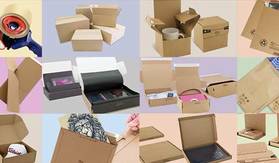
Cardboard boxes and packaging for eCommerce: how to minimise damage to your items
For your customers, the unboxing of your product is an important event. It should leave a great impression on them of not only the product, but the brand as a whole so getting this right is essential. But if they open up their package to find a battered vintage evening gown, broken sunglasses or scratched vinyl LP, they won't be impressed. In fact, damage due to inadequate packaging is a sure-fire way of ruining a customer's day and leaving a lasting feeling of being let down. If your products don't get from point A to B in one piece, then your box just isn't fit for the job. But how can you pick the right box? Here, we'll take you through a safety-first guide to packing and shipping your products to avoid damage and, ultimately, unhappy customers.
Why breakages are a big deal
As an eCommerce seller, you likely take exceptional care in how you produce your products. But this needs to extend to how you package them, too. If you take the view that damaged goods and packaging are "just one of those things", then you're risking a lot. Just take a look at the Trustpilot, Feefo, or platform-specific reviews for some of your competitors. Scroll down to the 3, 2 and 1-star reviews to find out what people complain about, and you'll likely find a fair few tales of dog-eared presentation boxes, scuffed exteriors, and customers forced to return broken products due to failed deliveries.
Damaged Products will Damage Reputations
Each instance of transit damage is a potential blow to your reputation, and even if you can fix the problem by shipping out a replacement right away, the fact that things weren't quite right first time around takes at least some of the shine off the transaction overall experience for your customer. To keep your reputation positive, damage-avoidance should always be a top priority each negative review can be a big step backward in building trust with any potential new customer. On top of this, dealing with damaged goods eats into your profit margins and takes up valuable time. If you find out one of your packages has been damaged in transit, you'll need to pay for a replacement product to be sent out to the customer as soon as possible - ultimately leaving you with excess delivery costs, wasted time, and lost profit. This process isn't just a major hassle, getting it wrong can risk your reputation taking another hit.
Stopping breakages: where things can go wrong

A common way that people and businesses try to limit the amount of damage their packages might receive is by sticking a fragile sticker on the side. This doesn't guarantee anything, though the package could fall, or be mishandled regardless of the sticker. A better approach is to identify precisely where your product is vulnerable, and to compensate for this through the packaging itself. Each product is different, and there are different things you should pay attention to with each. Some examples include:
- Individual craft items: take into account the materials used (e.g. glass or ceramics), and also identify any specific weak points that might need extra protection, such as joints, handl es, and surface decoration.
- Cosmetics and scented items: especially for items such as balms, creams and bath bombs, you should consider whether your products will need protection against drops and sudden movements.
- Items already in retail packaging: retail display boxes are typically designed with presentation rather than transit protection in mind, so make sure the item has plenty of protective packaging around it.
Once you've isolated potential risk points of your products, you can then pick out the best packaging solution to address them.
Box-in-box packaging
If you sell toys, games, or jewellery, your products might already be pre-boxed in branded, gift-quality packaging. This packaging will likely be part of your overall branding, and you've probably invested a fair amount of time making sure the quality is on par with the product itself. It's essential that this stays in mint condition during transit as your customer might wish to keep the retail box for storage or resale. In situations like this, twist-wrap packaging is a great go-to option as it's designed to fit 90% of all retail items and is variable height and width. Wrapping tightly around the contours of the gift box, it will provide additional buffering around the edges to prevent scuffed corners. And because it's a nice tight fit, it can help you stay within carrier size limits and avoid using messy void-fill.
Dealing with delicate items
If you sell glass and ceramic products, then smart layering is generally the key to providing reliable protection. Here are some of the ways you can layer your packaging:- Consider using void-fill paper for your first layer, perhaps with a double layer around vulnerable areas.
- With the box itself, you should aim for a snug fit. Opt for the smallest size box your item can lie comfortably in. Remember that you shouldn't have to force it into the box, but nor should you have loads of space to fill either.
- It may be worth using double-walled boxes, especially for heavier, delicate items, as they're sturdier and stronger than single-walled boxes.
- If you've got no choice but to use a poor fitting box, be sure to fill up any "dead space", as this can cause the item to move around in transit and this is where the risk of damage can be most significant. How you fill the void is a matter of personal preference, but it's best to choose an eco-friendly and plastic-free alternative to bubble wrap or polystyrene, such as void-fill paper or shredded cardboard both of which are biodegradable.
- Make sure you test for movement: you should be able to move the box in all directions without any noticeable shifting of the contents.
- Take into account any special environmental factors. Silica gel, for example, can be useful for clothing, electricals, and all items where you need to reduce the chances of humidity damage.
At the end of the day, keeping your products well-protected is an incredibly important part of your business. From books to LPs and jewellery to candles, you need to make sure your packaging is the right fit for your product not too small, not too big and that the level of padding is adequate enough to prevent damage. Choosing a double-walled box and layering your padding should keep your items safe, while keeping your packaging streamlined.
If you haven't found your ideal packaging solution yet, our Bespoke range is designed to meet your eCommerce needs, whilst keeping your products safe and protected during transit. If you'd like to find out more about our range, head over here for more information or contact us to arrange a quote for custom size and print.





Leave a comment